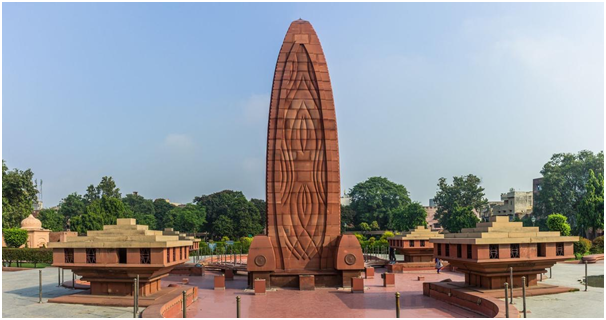Jallianwala Bagh massacre
Context: On April 13, 1919, A British Colonel named Reginald Edward Harry Dyer ordered troops to surround the Jaliawala compound, situated between houses and narrow lanes, and launched indiscriminate firing on the assembled men, women and children who lacked the means to escape. Some of them jumped into a well located within the premises to escape the bullets. According to the British, around 400 people were killed in the firing, the youngest of whom was nine-years-old and the oldest was 80. Indian historians peg the toll at 1,000
What happened at Jallianwala Bagh?
- April 13 saw celebrations for the Sikh festival of Baisakhi, which marks the onset of Spring and the harvest of winter crops.
- Simultaneously, the movement for independence from British rule had been steadily gaining ground in recent years, and an event was held at Jallianwala Bagh to defy colonial orders and protest against the recently passed Rowlatt Bills.
- These Bills curtailed the civil liberties of Indians and let colonial forces arrest people without any warrant or trial.
- One of the Acts was pushed through the Legislative Council ignoring objections of elected Indian representatives, leading to resentment among Indians. Some violent protests had been witnessed in cities of Delhi, Bombay (now Mumbai) and Lahore as well, even as MK Gandhi called for the launch of a non-violent peaceful protest at the time.
- Sir Michael O’Dwyer imposed martial rule in Lahore and Amritsar on April 11, but the order reached Amritsar only on April 14. He also sent Colonel Dyer, who was then holding the temporary rank of Brigadier General, from the Jalandhar cantonment to Amritsar.
- On April 13, a Sunday, Col Dyer’s troops marched through the town to warn against the assembly of more than four people. But the announcement did not reach most people, and devotees headed towards the Golden Temple. By 4 pm, many gathered for a public meeting against the arrest of Dr Satyapal and Dr Saifuddin Kitchlew for opposing the Rowlatt Act.
- Dyer saw the assembly as a violation of government orders. “They had come to fight if they defied me and I was going to give them a lesson……I was going to punish them. My idea from the military point of view was to make a wide impression,” Dyer said to the Hunter Committee of 1920 (also termed the Report of Disorders Inquiry Committee) that was setup to investigate the disturbances across cities.
- With his troops, Dyer entered the Bagh through a narrow alley, the only entry and exit path. The 1920 report noted that Dyer entered Jallianwala Bagh with 25 Gorkha soldiers and 25 Baluchis armed with rifles, 40 Gorkhas armed with only Khukris and two armoured cars. A crowd of around 10 to 12,000 was gathered there at the time.
- “Without giving the crowd any warning to disperse, which he considered unnecessary as they were in breach of his proclamation, he ordered his troops to fire and the firing continued for about ten minutes,” the report noted. It reported that no one in the crowd was carrying firearms though some may have been carrying sticks.
- In all, the soldiers fired 1,650 rounds. A later investigation brought the number of killed up to 379. No figure was given for the wounded and it was thought that it may have been three times the dead. Indian leaders expressed their anger and protested in response to the killings. Notably, Nobel laureate poet Rabindranath Tagore gave up his knighthood.
Who was General Dyer?
- Dyer was born in Murree in 1854, in present-day Pakistan, and was commissioned in the West Surrey Regiment in 1885 and then transferred to the Indian Army.
- He campaigned in Myanmar in 1886–87 and took part in World War I (1914–18) with charge of the Eastern Persian cordon, the purpose of which was to prevent German crossings into Afghanistan.
- The Jallianwala Bagh incident led to focus on his actions in particular. After the incident too, Dyer was known to engage in barbarity against Indians in at least one other incident. On April 10, 1919 Marcella Sherwood, a missionary, was cycling down the street in Amritsar when she was allegedly attacked. Some locals intervened and saved her.
- Six days after the Jallianwala Bagh massacre, Dyer was informed of how Sherwood was attacked and he issued an order that no one would walk through the street where Sherwood was attacked. Those who needed to pass through it, were told to crawl. Those disobeying these orders were to be flogged.
- As part of the Hunter Committee report, statements from Dyer given to it show that he did not show particular regret for his action on April 13, believing them to be justified to quell the crowd. He is quoted as saying in the report, “I had made up my mind. I was only wondering whether I should do it or not….The situation was very, very serious. I had made up my mind that I would shoot all men to death if they were going to continue the meeting.”
What happened to Dyer after Jallianwala Bagh?
- The Hunter Committee condemned the incident but did not impose any punishment on Dyer. Ultimately, the Commander-in-Chief of the Army directed Brig Gen Dyer to resign his appointment as Brigade Commander and informed him that he will receive no further employment in India.
- However, Dyer remained a divisive figure at the time. Imperialists at home lauded Dyer for his actions against what they termed as unrest in India. Conservative newspapers and organisations in the UK later arranged for a fund for Dyer and collected a significant amount.
- Then MP and later Prime Minister Winston Churchill said that Dyer’s actions could not be repeated or justified, stating in the UK Parliament, “Our reign in India or anywhere else has never stood on the basis of physical force alone, and it would be fatal to the British Empire if we were to try to base ourselves only upon it.”
| Practice Question
1. How has the Jaliawalan Bagh massacre impacted the national movement of India? |





